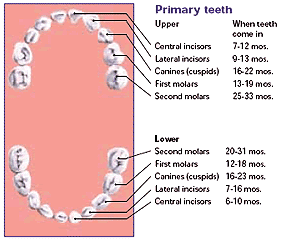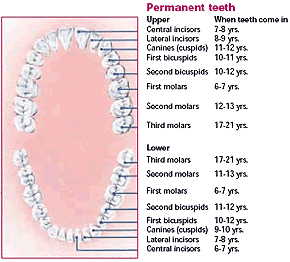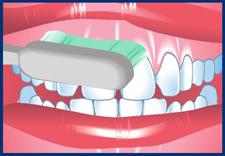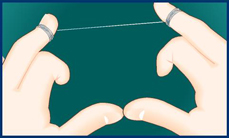You have a question - we have an answer!
At Forest Hill Children's Dentistry, we often hear the same questions from parents. We've put together a list of answers to those questions below, for your convenience.
What is Pediatric Dentistry?
Pediatric Dentistry is the branch of dentistry concerned with providing primary and comprehensive preventive and therapeutic oral health diagnosis, care, and consultative expertise for infants and children through adolescence, including those of all ages with special care needs.
When should my child first visit a dentist?
The Canadian Dental Association and the Canadian Academy of Pediatric Dentistry encourage the assessment of infants, by a dentist, within 6 months of the eruption of the first tooth or by one year of age. The goal is to have your child visit the dentist before there is a problem with his or her teeth. In most cases, a check-up every six months will let your child's dentist catch small problems early.
Your child needs to see the dentist by age two or
- You can find out if the cleaning you do at home is working.
- Your dentist can find problems right away and fix them.
- Your child can learn that going to the dentist helps prevent dental problems.
What happens at the first dental visit?
At this initial visit, the dentist should record a thorough medical and dental history. Parents should be prepared to review the prenatal, perinatal, and postnatal period of their child's development.
The oral examination at this early age is usually accomplished with the parent present in the office. It is most often only a visual exam. The child patient may be sitting in the parent's lap with the head in the dentist's lap (knee-to-knee position).
For older children, the dentist may want to take X-rays. X-rays show decay between the teeth that does not appear on the clinical examination. They will also show if teeth are coming in the way they should.
One important aspect of this visit is to discuss the child's risk of developing
The dentist will also evaluate the child's oral and dental development. The common question about "how many teeth at what age?" will be addressed. The dentist will also evaluate the need for fluoride supplementation. It may be important to discuss non-nutritive habits (finger sucking, pacifier), injury prevention, oral hygiene, and effects of diet on oral health.
If treatment is indicated, the dentist should be prepared to provide therapy or offer a referral.
At what age can I expect my child’s baby or adult teeth to come in?
All twenty baby (or primary) teeth come in by the time your child is two or three years old.
Primary Teeth
This chart tells you when baby teeth come in (or erupt) in most children.

If your child is getting his or her teeth and seems to be in pain, you can:
- Rub the gums with a clean finger.
- Rub the gums with a moist, cool cloth or allow the child to pacify on a chilled teething ring.
- If your child is still unhappy, your dentist, pharmacist or doctor can suggest an over-the-counter medicine to ease the pain.
Here's what you should not do:
- Do not use the kind of painkiller that can be rubbed on your child's gums. Your child may swallow it.
- Do not give your child teething biscuits. They may have sugar added or contain hidden sugars.
- Do not ignore a fever. Getting new teeth
does not make babies sick or cause a fever. If your child has a fever, consult with your doctor.
Permanent Teeth
This chart tells you when permanent teeth come in (or erupt) in most children

At age six or seven, the first adult (or permanent) teeth come in. They are known as the "first molars," or the "six-year molars." They come in at the back of the mouth, behind the last baby (or primary) teeth. They do not replace any baby teeth.
Also around age six, children start to lose their baby teeth. The roots slowly get weak, and the tooth falls out. Children lose baby teeth until they are about 12-years old.
It's okay for children to wiggle their baby teeth if they are loose. But it's not okay to use force to pull out a tooth that's not ready to come out. When a tooth comes out at the right time, there will be very little bleeding.
Why do the new permanent teeth look yellow?
Permanent teeth often look more yellow than primary teeth. Don’t worry, this is normal. However, it could also be caused by medicine your child took, by an accident that hurt a primary tooth, or by too much fluoride. Ask your dentist about this when you go for a check-up.
Can children get tooth decay?
Once your child has teeth, he or she is susceptible to tooth decay. Mother's milk, formula, cow's milk, fruit juice, and a variety of snacks all contain sugars. Bacteria present in the mouth can then utilize these sugars and produce acids which in turn cause demineralization of tooth enamel. This process of acid production occurs for approximately a 20 minute period following food consumption and left unchecked, may cause tooth decay. It is important to understand that many healthy foods that are an important part of a healthy diet may cause tooth decay and the challenge is to practice good dental health practices to prevent or minimize their effect.
What is Baby Bottle or Nursing decay?
Babies may get early childhood tooth decay from going to bed with a bottle of milk, formula or juice.
In order to prevent the occurrence of Baby Bottle Decay in your child,
- NEVER PUT YOUR CHILD TO SLEEP WITH A BOTTLE CONTAINING MILK, FORMULA OR JUICE. ONLY PLAIN WATER IS ACCEPTABLE.
- CLEAN YOUR CHILD’S TEETH AND GUMS IMMEDIATELY AFTER EACH FEEDING AND ESPECIALLY BEFORE BED.
If you give your child a bottle of milk, formula or juice at bedtime, stopping all at once will not be easy and will almost always result in a few nights of lost sleep. Here are some tips to help you:
- Put plain water in the bottle.
- If this is turned down, give your child a clean soother, a stuffed toy or a blanket.
- If your child cries, comfort him or her but do not give up.
- If this does not work, try watering down your child's bottle over a week or two, until there is only plain water left.
How do I know if my child has Baby Bottle or Early Childhood Tooth Decay?
Once your child has teeth, lift his or her lips once a month and check the teeth. Look for dull white, brown or black spots on all sides of the teeth. These may be on the tops of the teeth next to the gums or in the grooves of the baby molars. If you see any signs, go to the dentist right away. Early childhood tooth decay must be treated quickly. If not, your child may experience pain and/or infection and some teeth may be lost.
Since baby teeth are going to fall out why worry about treating the decay?
Some primary (or baby) teeth will be in your child's mouth until age 12. The tooth that needs to be fixed may be one of those. Broken teeth or teeth that are infected can hurt your child's health, damage permanent teeth, and cause significant pain or discomfort. To do a filling, the dentist removes the decay and "fills" the hole with metal, plastic or other materials. A filling can be a cheap and easy way to fix a problem that could be painful and cost more later because it stops decay from spreading deeper into the tooth.
If a filling is not done and decay spreads, the tooth may need to be pulled out. If this happens, your child may need a space maintainer to hold space for the permanent tooth.
When a baby tooth is missing, the teeth on each side may move into
What is the best way to clean my child’s teeth?
Young children are not able to clean their own teeth. As a parent, you must do it for them when they are very young and do it with them, as they get older.
When your child can tie his or her own shoes, your child is ready to do a good job brushing. You should check to make sure your child continues to maintain good brushing habits.
You should start cleaning your child's mouth even before your child has teeth. It gets both you and your child into the habit of keeping the mouth clean, and it gives baby teeth a clean place to come into. The goal here is to wipe all parts of the gums and teeth.
Here's how to do it:
- Lay your baby in a comfortable place.
- Make sure you can see into your baby's mouth.
- Use a soft baby brush or wrap your finger in a clean, damp washcloth. Then, brush or wipe your baby's gums and teeth.
- Do not use toothpaste until your child has teeth.
How to Brush
Step 1
Hold the toothbrush at a 45-degree angle to the teeth. Point the bristles to where the gums and teeth meet.

Step 2
Use gentle circles. Do not scrub. Clean every surface of every tooth. For the front teeth, use the "toe" or front part of the brush. Be gentle as you can hurt the gums by brushing too hard.
Toothbrushes and Toothpaste
The best kind of brush is soft, with rounded bristles. It should also be the right size for your child's mouth. You will need to buy a new toothbrush at about every 3 or 4 months.
Children can be hard on toothbrushes. If the bristles get bent or worn down, they will not do a good
Make sure the toothpaste has fluoride. Check the box or tube for the symbol of the Canadian Dental Association. This symbol means the toothpaste has fluoride. Use only a bit of toothpaste, about the size of a pea, and make sure your child spits it out.
As excessive swallowing of toothpaste by young children may result in dental fluorosis, children under 6 years of age should be supervised during brushing and only use a small amount (e.g. pea-sized portion) of toothpaste.
Children under three years of age should have their teeth brushed by an adult using only a small amount of toothpaste.
How to Floss
Step 1
Take a piece of floss about as long as your child's arm. Wrap it around your middle fingers, leaving about 2 inches between the hands. Use your index fingers to guide the floss between the teeth.

Step 2
Slide the floss between the teeth and wrap it into a "C" shape. It should wrap around the base of the tooth, where the tooth meets the gum.
Step 3
Wipe the tooth from bottom to top 2 or 3 times or until it is squeaky clean.
Be sure you floss both sides of each
Remember to move to a new part of the floss as you move from tooth to tooth.
Should my child always brush right before bed?
Yes. If you don't get rid of the germs, bacteria, and sugars that cause cavities, they have all night to do their dirty work. Plus, when your child is asleep, he or she does not produce as much saliva. This Saliva helps keep the mouth clean, so brushing at bedtime is very important.
How does nutrition play a role in tooth decay?
When your child eats or drinks sugars, the bacteria in your child's mouth mix with the sugars to make a mild acid. This acid attacks the hard outer layer of teeth, known as the enamel. It can make holes and cavities in the teeth.
The damage that sugars do depends on how much sugar goes into the mouth and how long it stays in the mouth.
Any kind of sugar will mix with germs in the mouth. Natural sugars can have the same effect on teeth as white or refined sugar out of the bag! Many healthy foods contain natural sugars such as milk.
If you put your child to bed with a bottle of milk, the milk stays in the mouth all night which may lead cavities. Unsweetened fruit juice may have no added sugar, but fruit juice has natural sugars in it. If your child is always sipping juice between meals, the teeth are being coated in sugars over and over again.
Water is the best drink to have between meals. Starchy foods, like teething biscuits, break down to make sugars. If these kinds of food stay in your child's mouth long enough, they will make the acid that can cause cavities. Your job is to clean your child's teeth, not to stop your child from having the foods they would normally eat.
Read the labels of the packaged food you buy. By law, every ingredient in
These are sugars you can look for on labels: corn sweeteners, corn syrup, dextrose, fructose, glucose, honey, maple syrup, molasses, and sucrose. Also, check to see if liquid medicines (such as cough syrup) have sugars. Ask your doctor or pharmacist to give you medicines that are sugar-free.
Snacks
Growing children need and like snacks. Here are some smart ways to give snacks:
Limit the number of times a day your child eats or drinks sugars. If your child sips juice or pop while playing, he or she will have sugars in the mouth over and over again. Water is the best drink to have between meals.
Do not give your child sugar-rich foods that stay in the mouth for a long time like gum with sugar in it, suckers, and other hard candy. Stay away from soft, sticky sweets that get stuck in the mouth such as toffee, raisins, and rolled-up fruit snacks.
Keep good snacks handy where your child can get them. Have carrot sticks or cheese cubes on the bottom shelf of the fridge. Children like small things like small boxes of cereal, small fruits and vegetables, and small packs of nuts or seeds (provided they are safe for your child). Keep them in a low cupboard.
To keep your child from asking for sweets, do not buy them. If they are not in the house, you can't give them out. If you do serve sweets, limit them to meals. When your child is eating a meal, there is more saliva in the mouth. This helps to wash away the sugars.
What is fluoride and how does it help prevent tooth decay?
Fluoride is a mineral found in nature. It makes the hard outer layer of teeth, called enamel, stronger. When the outer layer is strong, teeth are less likely to get cavities.
Children can get fluoride from four different sources:
- In the water
- In fluoride toothpaste
- In fluoride treatments
- In fluoride supplements (pills or lozenges)
Adding fluoride to the water is the best way to provide fluoride protection to a large number of people at a low cost. That is why many towns and cities put fluoride in the water. Fluoride is also in most toothpaste.
As excessive swallowing of toothpaste by young children may result in dental fluorosis, children under 6 years of age should be supervised during brushing and only use a small amount (e.g. pea-sized portion) of toothpaste. Children under three years of age should have their teeth brushed by an adult using only a smear of toothpaste.
If you live somewhere that does not put fluoride in the water and your dentist thinks your child is likely to get cavities, he or she may suggest that your child
This is called a fluoride supplement. The amount your dentist suggests will depend on your child's age and how much fluoride (if any) is in the water naturally.
To give your child even more protection against cavities, your dentist may suggest a fluoride treatment. It is given when your child has a check-up.
What about pacifiers and thumb sucking?
It is normal for babies to suck because it helps them relax. By the time your child is two or three years of age, he or she has less need to suck. If your child still likes to suck, a soother is better than sucking a thumb because you can control when and how your child uses a soother. You can't control a thumb going into the mouth.
Never put sugar, honey or corn syrup on a soother. They can cause cavities. It's best to get your child to stop sucking before permanent teeth come in, at about age five. If a child keeps sucking a soother or thumb after the permanent teeth have come in, it could cause problems with how the jaw and teeth grow.
What is a sealant?
Once your child has permanent molars, your dentist may suggest sealing them to protect them from cavities. A sealant is a kind of plastic that is put on the chewing surface of the molars. The plastic seals the tooth and makes it less likely to trap food and germs.
Will my child need braces?
A pediatric dentist can identify the development of malformed bites in children as early as 2-3 years of age. Early intervention can reduce the need for major orthodontic treatment at a later age. The periods in child development in which orthodontic intervention is best applied is broken into three stages:
Stage I – Early Treatment:
This stage encompasses children between the ages of 2 to 6 years. During this stage, pediatric dentists will look closely to identify underdeveloped dental arches, the premature loss of primary teeth, and harmful effects due to habits such as
Treatment initiated at this stage of development is often very successful and often can eliminate or reduce the need for future orthodontic or orthopedic treatment.
Stage II – Mixed Dentition:
This stage encompasses children aged 6 to 12 years and is marked by the eruption of the permanent front teeth and 6-year molars. The pediatric dentist will examine patients to identify potential problems related to dental misalignment. This is an optimal time to start orthodontic treatment, if necessary, as a child’s hard and soft tissues are usually very responsive to orthodontic or orthopedic forces.
Stage III – Adolescent Dentition:
This stage encompasses children aged older than 12 years and is marked by the eruption and development of all permanent teeth and the development of the final bite relationship. The most common form of orthodontic intervention is the use of braces to reposition and realign teeth